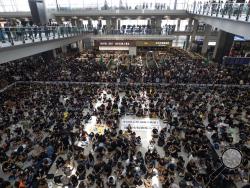HONG KONG (AP) — Protesters clogged the departure area at Hong Kong's reopened airport Tuesday, a day after they forced one of the world's busiest transport hubs to shut down entirely amid their calls for an independent inquiry into alleged police abuse.
More than 100 flights were cancelled as thousands of protesters occupied the airport's main terminal for the fifth consecutive day. After filling up two separate arrivals halls, demonstrators have streamed into the departure area despite increased security measures designed to keep them out.
Passengers struggled to get past the sitting protesters and into the immigration section.
Some flights were able to take off earlier Tuesday, relieving some of the pressure from Monday's cancellation of more than 200 flights. The central government in Beijing ominously characterized the protest movement as something approaching "terrorism" that posed an "existential threat" to the local citizenry.
Meanwhile, paramilitary police were assembling across the border in the city of Shenzhen for exercises in what some saw as a threat to increase force brought against the mostly young protesters who have turned out in their thousands over the past 10 weeks.
Hong Kong leader Carrie Lam said the ongoing instability, chaos and violence have placed the city on a "path of no return."
The demonstrators have shown no sign of letting up on their campaign to force Lam's administration to respond to their demands, including that she step down and entirely scrap legislation that could have seen criminal suspects sent to mainland China to face torture and unfair or politically charged trials.
While Beijing tends to define terrorism broadly, extending it especially to nonviolent movements opposing government policies in minority regions such as Tibet and Xinjiang, the government's usage of the term in relation to Hong Kong raised the prospect of greater violence and the possible suspension of legal rights for those detained.
Demonstrators have in recent days focused on their demand for an independent inquiry into what they call the police's abuse of power and negligence. That followed reports and circulating video footage of violent arrests and injuries sustained by protesters.
Some protesters have thrown bricks, eggs and flaming objects at police stations and police said they arrested another 149 demonstrators over the weekend, bringing the total to more than 700 since early June. Police say several officers have suffered burns, bruises and eye damage inflicted by protesters.
Lam told reporters Tuesday that dialogue would only begin when the violence stopped. She reiterated her support for the police and said they have had to make on-the-spot decisions under difficult circumstances, using "the lowest level of force."
"After the violence has been stopped, and the chaotic situation that we are seeing could subside," Lam said, "I as the chief executive will be responsible to rebuild Hong Kong's economy ... to help Hong Kong to move on."
She did not elaborate on what steps her government will take toward reconciliation. After two months, the protests have become increasingly divisive and prompted clashes across the city.
The airport shutdown added to what authorities say is already a major blow to the financial hub's crucial tourism industry.
Kerry Dickinson, a traveler from South Africa, said she had trouble getting her luggage Tuesday morning.
"I don't think I will ever fly to Hong Kong again," she said.
The protests early on were staged in specific neighborhoods near government offices. However, the airport protest was had a direct impact on business travel and tourism. Analysts said it could make foreign investors think twice about setting up shop in Hong Kong, which has long prided itself as being Asia's leading business city with convenient air links across the region.
The black-clad protesters Tuesday held up signs in Simplified Chinese and English to appeal to travelers from mainland China and other parts of the world. "Democracy is a good thing," said one sign in Simplified Chinese characters, which are used in mainland China instead of the Traditional Chinese script of Hong Kong.
Adding to the protesters' anger, Hong Kong's Cathay Pacific Airways told employees in a memo that the carrier has a "zero tolerance" for employees joining "illegal protests" and warned violators could be fired.
Hong Kong was promised democratic rights not enjoyed in Communist Party-ruled mainland China when Beijing took over what had been a British colony in 1997, but some have accused Beijing of steadily eroding their freedoms. Those doubts are fueling the protests, which build on a previous opposition movement that shut down much of the city for seven weeks in 2014 that eventually fizzled out and whose leaders have been imprisoned.
While China has yet to threaten sending in the army — as it did against pro-democracy protesters in Beijing in 1989 — the exercises in Shenzhen were a further demonstration of its ability to crush the demonstrations, even at the cost to Hong Kong's reputation as a safe haven for business and international exchange. Images shown on the internet showed armored personnel carriers belonging to the People's Armed Police driving in convoy Monday toward the location of the exercises just across the border from Hong Kong.
The People's Liberation Army also stations a garrison in Hong Kong, which recently released a video showing its units combating actors dressed as protesters. The Hong Kong police on Monday also put on a display of armored car-mounted water cannons that it plans to deploy by the middle of the month.
___
Associated Press photographer Vincent Thian in Hong Kong contributed to this report.

